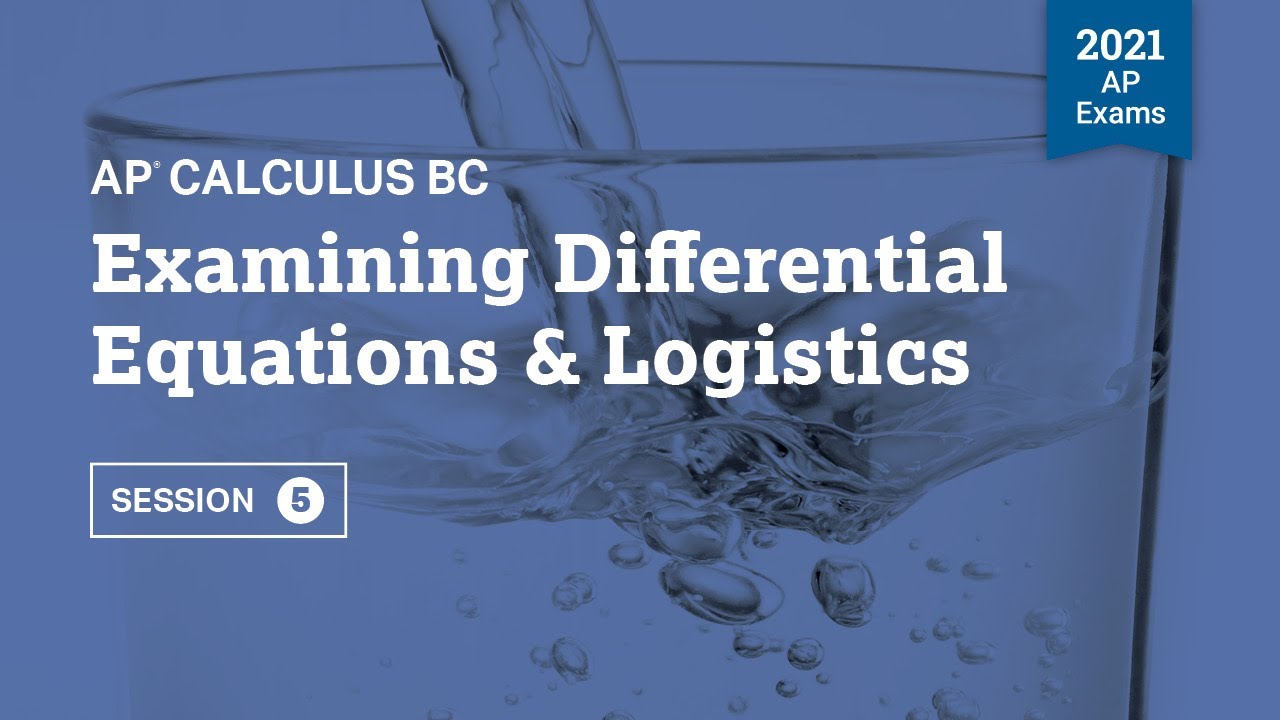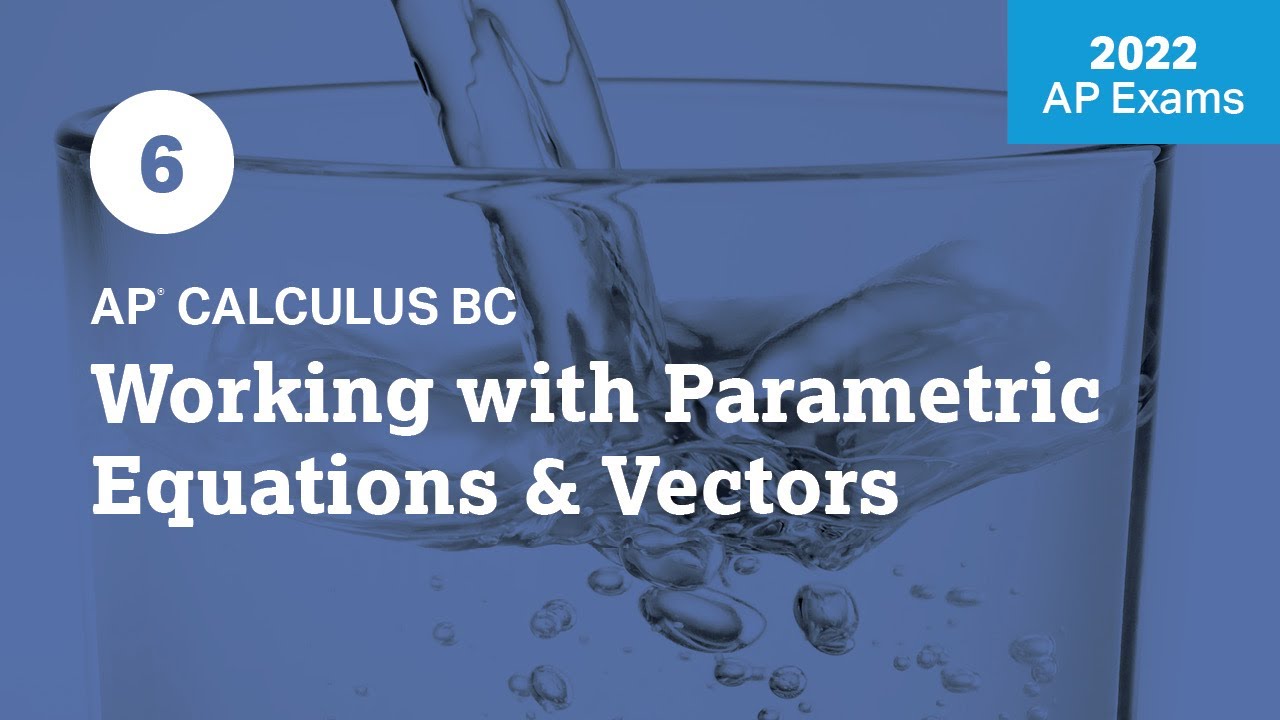2022 Live Review 2 | AP Calculus BC | Euler's Method, Logistics, and Differential Equations
TLDRIn this engaging AP Calculus BC review session, instructors Tony and Brian Passwater delve into differential equations, including both basic and logistic forms. They guide students through various problems, emphasizing the importance of recognizing equation structures and applying concepts like Euler's method and understanding logistic growth models. The session aims to boost students' confidence and prepare them for the upcoming AP exams, offering insights into problem-solving strategies and exam techniques.
Takeaways
- 📚 The session focuses on differential equations, emphasizing their importance in AP Calculus BC, particularly in Unit 7.
- 👨🏫 The instructors, Tony and Brian Passwater, aim to provide a comprehensive review to boost students' confidence and exam scores.
- 📈 Differential equations are central to the session, with an emphasis on recognizing and working with logistic differential equations.
- 🌐 The session includes a review of the logistic growth model (dy/dt = k*y*(1-y/L)), which is key for BC level students.
- 🔢 Practice problems are provided to help students identify and work with separable differential equations, a common type on the AP exam.
- 📊 Euler's method is discussed as a technique for approximating solutions to differential equations, with a focus on its application in the exam.
- 🎯 The session highlights the importance of understanding the context of problems, such as recognizing logistic growth in real-world scenarios.
- 📝 Students are encouraged to practice with provided materials and to review the handouts and QR codes for additional resources.
- 🌟 The instructors stress the value of repetition and pattern recognition in solving differential equation problems efficiently.
- 📌 The session includes a review of key calculus concepts, such as derivatives and integrals, as they relate to differential equations.
- 🚀 The goal of the session is to equip students with the knowledge and skills needed to tackle differential equations on the AP Calculus BC exam.
Q & A
What is the main focus of the video?
-The main focus of the video is to review differential equations in preparation for the AP Calculus BC exam, specifically looking at logistic differential equations and Euler's method.
Who are the presenters in the video?
-The presenters in the video are Tony and Brian Passwater, both AP Calculus teachers.
What is the significance of the logistic differential equation in the course and exam?
-The logistic differential equation is significant as it occupies an entire unit (Unit 7) in the course and exam description, and it is a key topic that students need to understand for the AP Calculus BC exam.
How does the video help students with the concept of differential equations?
-The video helps students by providing a detailed explanation of differential equations, including the logistic differential equation, and by working through various problems to demonstrate how to solve them.
What is Euler's method and how is it used in the video?
-Euler's method is a numerical technique used to solve ordinary differential equations (ODEs) with a given initial value. In the video, it is used to approximate solutions to differential equations through a step-by-step process.
What is the purpose of the practice questions in the video?
-The practice questions serve to reinforce the concepts learned and help students apply their knowledge of differential equations, particularly logistic differential equations and Euler's method, in a variety of contexts.
How does the video address the topic of limits in the context of differential equations?
-The video addresses limits through a specific problem that involves evaluating a limit using L'Hôpital's rule and the second fundamental theorem of calculus, demonstrating how these concepts are applied when dealing with differential equations.
What is the role of the point-slope formula in Euler's method as discussed in the video?
-The point-slope formula is used in Euler's method to find the equation of the line that approximates the solution curve at a given point, using the derivative as the slope and the initial point as part of the process.
How does the video handle the concept of carrying capacity in logistic differential equations?
-The video explains that the carrying capacity is a key parameter in logistic differential equations, representing the maximum population size that the environment can sustain indefinitely. It is used in the logistic growth model to show how population growth slows as it approaches this capacity.
What additional resources are provided for students to access the materials discussed in the video?
-Students are provided with a QR code and a URL that leads to a drive folder containing the handouts and additional problems discussed and used during the video.
Outlines
📚 Welcome to AP Calculus Review Session 2
The video begins with greetings to AP Calculus BC students and introduces the second session of the daily review for 2022. The hosts, Tony and Brian Passwater, emphasize the importance of differential equations, which occupy a significant portion of the course and exam. They plan to cover various problems and concepts, including Euler's method and logistic differential equations, to boost students' confidence and understanding of the topic.
🧠 Understanding Differential Equations and Logarithmic Growth
The paragraph delves into the specifics of differential equations, highlighting the difference between AB and BC calculus students' focus areas. It discusses the logistic differential equation's real-life applications and the importance of recognizing its formula. The hosts also introduce practice questions to help students identify logistic differential equations and separate them from other types of equations.
🔍 Practicing with Differential Equations
This section continues the discussion on differential equations, focusing on practice questions to help students distinguish between separable and non-separable equations. The hosts explain the concept of separable equations and provide examples of how to identify and work with them. They also discuss the challenges of comparing answers and the importance of writing down calculations for clarity.
📈 Euler's Method and Problem-Solving Strategies
The paragraph introduces Euler's method, a technique for approximating solutions to differential equations. The hosts explain the method's setup and provide a step-by-step example of how to apply it. They also discuss the use of linear approximations and the point-slope formula in solving these problems. Additionally, they mention the importance of understanding the method's iterative process and the utility of labeling equations.
🌐 Modeling with Logistic Differential Equations
This section focuses on logistic differential equations, emphasizing their importance in modeling growth and decay. The hosts present a problem involving the spread of a meme among AP Calculus students, using it to illustrate how to set up and solve for a logistic differential equation. They highlight the importance of identifying the carrying capacity and the rate of growth or decay, as well as the need to match the equation to the given scenario.
🧬 Solving Differential Equations and Verifying Solutions
The paragraph discusses the process of solving differential equations, emphasizing the importance of separating variables and integrating. The hosts provide a detailed example of solving a differential equation, including the potential pitfalls and the need for accurate algebra and calculus. They also touch on the concept of verifying solutions, explaining how to check if a given solution fits the original differential equation.
📊 Interpreting Logistic Growth through meerkat Population Dynamics
This section uses a meerkat population growth scenario to illustrate the logistic differential equation's application. The hosts explain how to interpret the equation's parameters, such as the carrying capacity and the rate of growth. They also discuss the behavior of the population as it approaches the carrying capacity and how to determine if the population is increasing or decreasing based on the value of m (population size) in relation to the carrying capacity.
🎓 Euler's Method: Alternative Approach with Tables
The hosts introduce an alternative method for applying Euler's method, using a table to organize and calculate values. They explain the process of determining step sizes, calculating derivatives, and iterating through the method. The emphasis is on labeling and showing work clearly to ensure that the process can be followed and credited correctly. The example provided walks through the steps of approximating a function value using Euler's method.
📝 Free Response Question Breakdown
The paragraph presents a free response question from a practice exam, covering various aspects of calculus related to differential equations. The hosts break down the question into parts A and B, discussing how to sketch a slope field based on a given differential equation and how to determine local extrema using the derivative of a function. They provide a detailed explanation of the process, including the application of l'Hôpital's rule and the second fundamental theorem of calculus.
🌟 Wrapping Up the Session with Differential Equations
In the concluding part, the hosts summarize key takeaways from the session on differential equations. They remind students to be prepared for context-based questions and to understand the properties of logistic growth. They also provide resources for further study and practice, including a URL and QR code for additional handouts. The hosts encourage students to keep studying and express their confidence in the students' abilities as they approach the upcoming AP exams.
Mindmap
Keywords
💡Differential Equations
💡Logistic Differential Equation
💡Carrying Capacity
💡AP Calculus BC
💡Euler's Method
💡Integration Techniques
💡Critical Numbers
💡L'Hopital's Theorem
💡Slope Field
💡Initial Condition
Highlights
The session focuses on differential equations, emphasizing their importance in the AP Calculus BC curriculum and exam.
Instructor Tony and Brian Passwater discuss the logistics of differential equations and their real-world applications.
The session covers the logistic differential equation, which is a key topic in the AP Calculus BC exam.
The instructors provide a comprehensive review of the material, aiming to boost students' confidence and exam scores.
The session includes a variety of practice problems to help students understand and apply the concepts of differential equations.
Instructor Tony Record and Brian Passwater share insights on how to approach multiple-choice and free-response questions related to differential equations.
The session emphasizes the importance of recognizing the form of logistic differential equations and how to identify them on exams.
Students are guided through the process of solving differential equations using Euler's method, highlighting the iterative nature of the process.
The instructors discuss the concept of carrying capacity in logistic growth models and how it affects the growth rate of a population.
The session provides strategies for tackling complex problems, such as using the point-slope formula and understanding the properties of derivatives.
Instructor Tony shares a personal anecdote about his cat, adding a touch of humor and relatability to the session.
The session concludes with a comprehensive free-response question that integrates various concepts of differential equations, providing a practical application of the reviewed material.
Instructor Brian introduces the concept of L'Hopital's theorem and its application in evaluating limits, a crucial technique for solving certain types of calculus problems.
The session encourages students to review the provided materials and practice problems to reinforce their understanding of differential equations.
Instructor Tony emphasizes the importance of good notation and showing work when solving problems, which can earn students valuable partial credit on exams.
The session wraps up with a reminder of the upcoming AP Calculus BC exam, motivating students to continue their studies and preparation.
Transcripts
Browse More Related Video

2021 Live Review 5 | AP Calculus BC | Examining Differential Equations & Logistics

2022 Live Review 1 | AP Calculus BC | Integration Techniques for AP Calculus BC

1 | MCQ | Practice Sessions | AP Calculus BC

2021 Live Review 4 | AP Calculus BC | Understanding Integration Techniques

2022 Live Review 6 | AP Calculus BC | Working with Parametric Equations and Vectors

3 | FRQ (No Calculator) | Practice Sessions | AP Calculus BC
5.0 / 5 (0 votes)
Thanks for rating: